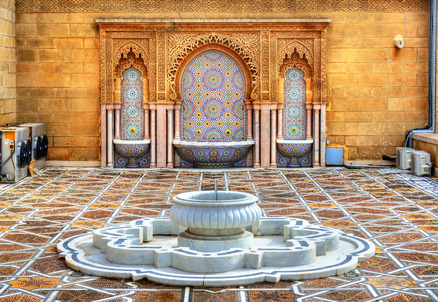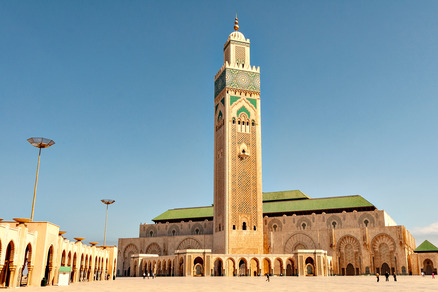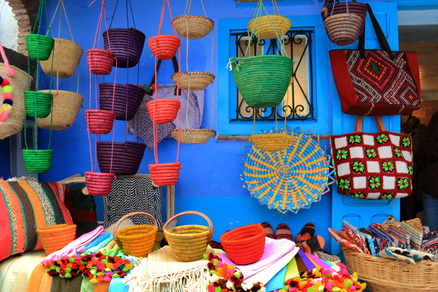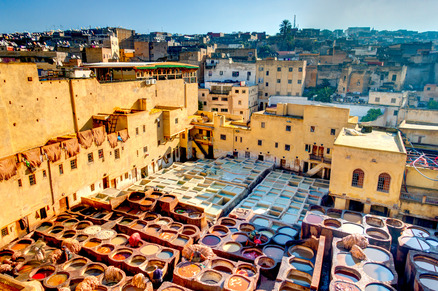

This Morocco travel guide is your key to unlocking those experiences. From towering minarets to desert camps, Morocco fuses tradition and modernity. Whether you’re strolling through a blue-washed town, discovering Berber villages in the Atlas Mountains, or bargaining for carpets in a Fes souk, there’s an adventure waiting. Let this guide inspire your journey and prepare you for the rhythm of Moroccan life.
Best Time to Visit Morocco
Spring (March to May) and autumn (September to November) are the most comfortable seasons to visit Morocco. During these months, the weather is pleasantly warm across the country, making it ideal for exploring cities, hiking in the mountains, and desert tours. Any comprehensive Morocco travel guide will highlight these months as the best time to explore.
Summer can be scorching, especially in the interior regions and the Sahara, where temperatures regularly exceed 40°C (104°F). However, it’s a great time to visit coastal towns like Essaouira or Tangier where the Atlantic breeze keeps things cooler. A good Morocco travel guide can help you plan the perfect coastal itinerary during this season.
Winter is mild along the coasts but can be chilly in the Atlas Mountains and the desert. Snow can fall in higher elevations, so if you’re visiting for a ski trip or mountain hikes, this season has its own charm.
Top Destinations in Morocco

Marrakech
The Red City of Marrakech is often the gateway for travellers. Its main square, Jemaa el-Fnaa, is a dynamic stage of musicians, snake charmers, and storytellers. Just off the square, souks (markets) spill over with spices, lanterns, leather, and textiles. Explore the tranquil Majorelle Garden or lose yourself in the ornate Bahia Palace.
Rooftop cafes provide a peaceful retreat from the buzzing streets below. Don’t miss the Koutoubia Mosque, whose 12th-century minaret dominates the skyline. At night, the city pulses with the rhythms of Gnawa music and the aroma of grilled meats.
Fes
Step into a living museum in Fes, Morocco’s oldest imperial city. Its medina, Fes el Bali, is a UNESCO World Heritage site and home to Al Quaraouiyine University, considered the world’s oldest continually operating educational institution. Any detailed Morocco travel guide will point you to Fes as a must-visit destination for history and culture enthusiasts.
The city is also known for its tanneries. Visit Chouara Tannery for a rooftop view of centuries-old leather-dying pits—prepare for strong scents, but the colourful scene is unforgettable. Wander winding alleys to discover mosaic fountains, madrasas (Islamic schools), and artisan workshops.
Chefchaouen

Known as the “Blue Pearl,” Chefchaouen is a photographer’s dream. Tucked into the Rif Mountains, its every wall, door, and step seems dipped in sky-blue hues. The town is quieter than Morocco’s major cities, offering a peaceful retreat.
Local markets are filled with wool garments, woven blankets, and natural beauty products. Climb to the Spanish Mosque for panoramic views of the valley. Hikers can explore nearby trails in Talassemtane National Park.
No Morocco travel guide is complete without mentioning the Sahara. The vast golden dunes of Erg Chebbi near Merzouga create a surreal landscape. Take a camel trek across the sands, spend a night in a Berber camp, and watch stars emerge in a sky untouched by city lights. A trusted Morocco travel guide can help you plan the best desert experience tailored to your travel style.
Enjoy sandboarding or hop on a 4×4 for an off-road adventure. Early risers are rewarded with breathtaking desert sunrises. The experience connects you to nature and Morocco’s nomadic traditions.
Essaouira
This laid-back coastal town offers cool ocean breezes, artistic vibes, and rich history. Wander the medina, a mix of French, Portuguese, and Moroccan influences. The Skala de la Ville—seaside ramparts with old cannons—offers gorgeous views of the Atlantic.
Essaouira is a hub for windsurfing and kitesurfing. Seafood is abundant and delicious; try freshly grilled sardines or seafood tagine at the port. Art galleries and music festivals add a creative flair to this fishing town.
Getting Around
- Trains connect major cities and are reliable and affordable.
- Buses (like CTM and Supratours) serve towns and more remote destinations.
- Taxis come in two types: petit taxis for city rides and grand taxis for longer routes.
- Car rentals are ideal for exploring the countryside or coastal roads.
Must-Try Moroccan Dishes
Moroccan cuisine is deeply flavourful and often slow-cooked. Here are some must-tries:
- Tagine: A stew made with lamb, chicken, or vegetables, slow-cooked in a cone-shaped pot.
- Couscous: Traditionally eaten on Fridays, served with vegetables and meat.
- Harira: A rich tomato and lentil soup, often eaten during Ramadan.
- Pastilla: A savoury pastry filled with pigeon or chicken and dusted with cinnamon and sugar.
- Mint tea: The national drink, always served with a smile and sweetened generously.
Street food like msemen (flaky pancakes) or sardine sandwiches are also worth a taste.
Cultural Etiquette

Morocco is a Muslim-majority country with conservative values. Dressing modestly, especially in rural areas or religious sites, is appreciated. Avoid public displays of affection. Greet people respectfully and learn a few phrases like “Salam Alaikum” (peace be upon you). A good Morocco travel guide will always emphasize cultural etiquette to help travelers engage respectfully and meaningfully with locals.
Photography: Always ask before taking someone’s photo, especially in markets or traditional areas. Fridays are holy days, so be mindful when visiting religious landmarks.
Tipping is expected in restaurants, taxis, and for tour guides—around 10% is standard.
Where to Stay
Accommodation in Morocco ranges from luxury hotels to humble guesthouses. Riads—traditional Moroccan homes with inner courtyards—offer a unique stay, especially in cities like Marrakech and Fes.
Budget travellers can find affordable hostels and mid-range hotels, while those seeking indulgence can stay in opulent resorts or boutique riads. In rural areas or the desert, Berber camps and eco-lodges provide an immersive experience.
For the best experience, consider staying inside the medina in old cities to truly soak in the local culture.
5 Essential Experiences in Morocco
- Watch the sunset in the Sahara
- Get lost in Fes’s ancient medina
- Hike in the Atlas Mountains
- Relax in a hammam (traditional bathhouse)
- Barter in the souks of Marrakech
Each experience introduces you to the country’s soul and history.
Practical Tips and Safety
Morocco is generally safe for tourists. Still, take standard precautions:
- Keep valuables secure.
- Avoid wandering medinas late at night alone.
- Use official taxis or transport services.
SIM cards with data are inexpensive and available at the airport or local shops. Tap water isn’t always drinkable—stick to bottled water, especially in rural areas.
Bring sun protection, layers for cool evenings, and a power adapter for European plugs (Type C/E).
Suggested Itinerary
A classic 10-day Morocco itinerary could look like:
- Days 1–2: Explore Marrakech (souks, gardens, palaces)
- Days 3–4: Travel to Fes via Atlas Mountains, overnight stop in Midelt
- Days 5–6: Explore Fes and nearby Meknes or Volubilis
- Days 7–8: Head to Merzouga for desert camping
- Days 9–10: Return via Ouarzazate and visit Ait Ben Haddou
Adjust your route based on interests—add Chefchaouen for calm, Essaouira for beach vibes, or more days hiking.
Why Choose This Morocco Travel Guide
This Morocco travel guide is more than a checklist—it’s a curated roadmap to one of the world’s most intriguing destinations. It blends practical advice with cultural insights, helping you go beyond the surface.
Whether you’re a solo traveller, couple, or family, this guide helps you explore Morocco with confidence. Let it shape a trip filled with connection, adventure, and unforgettable moments.
Looking for more travel inspiration? Check out our other travel guides.

